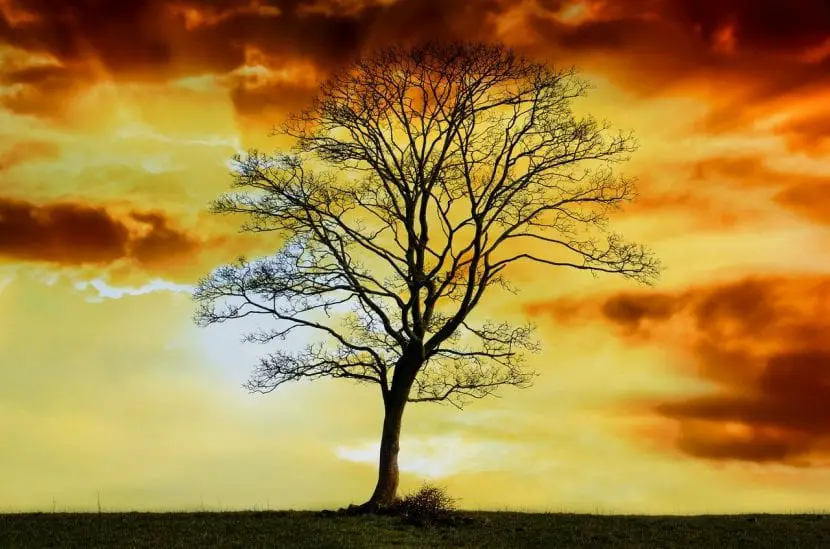

Leaves are very important for plants: without them, they could not photosynthesize and therefore grow. But there are some who live in areas where the winter climate is too cold that have had to develop a very curious strategy to survive: drop its precious leaves.
These parts are very delicate and fragile, so maintaining them during the winter season would be a huge waste of energy. But, How do deciduous plants survive in winter?
How can leafless plants stay alive in winter?


When you look, for example, at a tree without leaves, you might immediately think that it is dry; not in vain, if it does not have leaves … how can it breathe? Well, surprisingly, it does, manages to stay alive thanks to spongy tissue pores called lenticels found both in the trunk and in the branches of plants with secondary growth, that is, in those in which there are two lateral meristems (they are tissues responsible for growth), which increase the diameter of the trunk more than its length.
Once the vegetable being has run out of leaves, the lenticels take care of everything. Without them they could not exchange gases between the atmosphere and the interior of the crust, and therefore could not survive winter, during a season in which the lack of light, low temperatures, snow and hail put them to the test. to the rest of the animals and plants that live in the fields and forests.
Thus, while the external appearance of the plant seems to indicate that it is asleep, the interior of the trunk and branches is frantic activity to be able to continue with the respiration and the synthesis of enzymes that will stimulate the growth of the buds as the time begins to improve.
What are lenticels?


Lenticels They are bumps that are found both on the trunk and on the branches. These have a hole through which gases are exchangedand by which plants can perform both respiration and perspiration.
The size varies depending on the species: some are large, such as the Prunus serrulatabut most of the time they go unnoticed, since their color can be white, cream or yellow, colors that the branches and trunks also tend to have. In fact, they only look good when the trunk is a darker color.
What are the characteristics of deciduous plants?


Deciduous or deciduous plants are those that lose all the leaves at some time of the year. This time varies greatly depending on the climate, so, for example in the dry tropics, we will see that they lose them just before the dry season, since if they kept them they would lose such an amount of water that their survival would be at risk.
On the contrary, in temperate regions, where the seasons are well marked and where winter temperatures drop below 0 degrees, many species stop feeding their leaves, causing their death and subsequent fall.
But even if it is hard to believe, this is not a total loss, neither for tropical plants nor for those that live in temperate or cold zones. The leaves as they fall to the ground they decompose, releasing the nutrients that were used to create them. Much of these nutrients will be absorbed by the roots, which will be used again by the plant, for example to create new leaves.
Examples of deciduous plants
There are many species that lose all their leaves at some time of the year, for example the following:
Adansonia digitata


Known as baobab, it is a tree native to the south of the Sahara, in Africa, which reaches a height of 25 meters and a trunk of more than 40 meters in circumference. Its leaves are compound, of a beautiful green color, that fall before the dry season. It does not resist frost.


Related article:
Baobab (Adansonia digitata)
Delonix direction


Image – Wikimedia Commons / Anna Anichkova
Known as flamboyán or chivato, it is a tree native to Madagascar that reaches a height of 12 meters. Its crown is parasolate, composed of pinnate leaves that can fall before the dry season, or if it is grown in temperate climates in autumn. It resists weak frosts down to -1ºC.


Related article:
Flamboyant
Fagus sylvatica


Fagus sylvatica ‘Atropurpurea’. Image – Treeseedonline.com
Known as the common beech, it is a tree native to Europe that reaches a height of up to 40 meters. Its crown is rounded and very dense, composed of green, purple or variegated leaves depending on the variety and / or cultivar that fall in autumn-winter. Resists up to -18ºC.


Related article:
Beech, a majestic tree
Almond


Known as almond tree, it is a shrub or small tree native to the Mediterranean region that reaches a height of 5-6 meters. It has a quite branched crown, somewhat open, with green, lance-shaped leaves that fall in autumn-winter. Resists up to -7ºC.


Related article:
The almond tree, a beautiful garden tree
Did you find it interesting?
